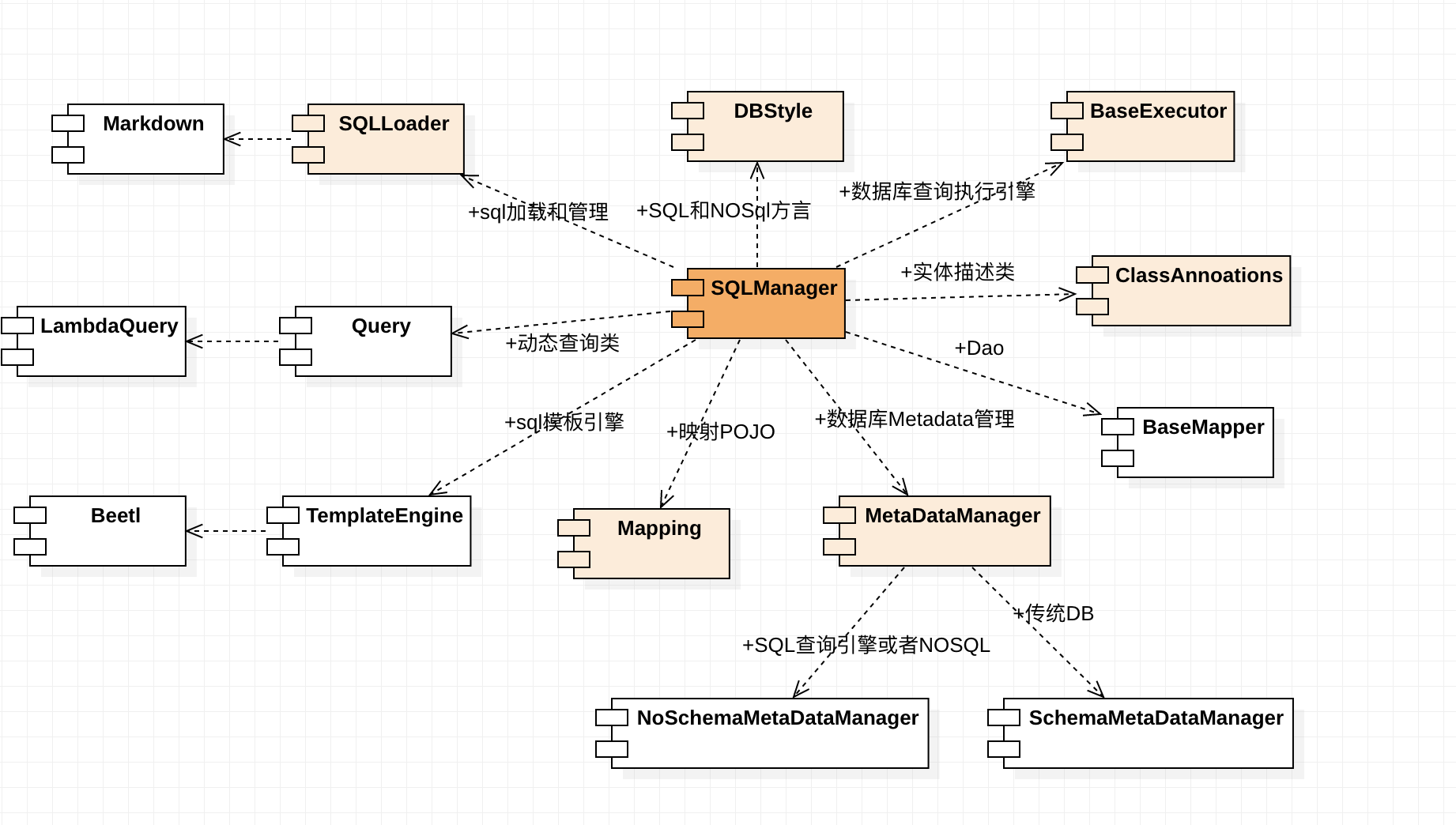内容简介:实现db.dynamicSql 方法,此方法在从2升级到3的时候,遗漏了其实现。参考例子中的includeDynamicSql unique方法未查询到结果集,抛出的异常信息里增加了 主键信息,以方便在未打开DebugInterceptor的时候仍然能看...
- 实现db.dynamicSql 方法,此方法在从2升级到3的时候,遗漏了其实现。参考例子中的includeDynamicSql
- unique方法未查询到结果集,抛出的异常信息里增加了 主键信息,以方便在未打开DebugInterceptor的时候仍然能看到错误详细信息
<dependency>
<groupId>com.ibeetl</groupId>
<artifactId>beetlsql</artifactId>
<version>3.3.1-RELEASE</version>
</dependency>
BeetlSQL 的目标是提供开发高效,维护高效,运行高效的数据库访问框架,以我20年在电信,金融以及互联网天天CRUD的经验总结得来的框架,适用范围广。目前支持的数据库如下
- 传统数据库:MySQL,MariaDB,Oralce,Postgres,DB2,SQL Server,H2,SQLite,Derby,神通,达梦,华为高斯,人大金仓,PolarDB 等
- 大数据:HBase,ClickHouse,Cassandar,Hive
- 物联网时序数据库:Machbase,TD-Engine,IotDB
- SQL查询引擎:Drill,Presto,Druid
- 内存数据库:ignite,CouchBase
编译源码
git clone https://gitee.com/xiandafu/beetlsql mvn clean package mvn clean install #如果想修改源码
注意:BeetlSQL3 集成了Spring,以及支持大数据等,就算配置了国内镜像,也可能需要很长时间下载大数据依赖包,为了让编译快速通过,你需要进入pom.xml ,屏蔽sql-integration,sql-db-support,sql-jmh三个模块
<modules> <!--核心功能 --> <module>sql-core</module> <module>sql-mapper</module> <module>sql-util</module> <module>sql-fetech</module> <!-- 打包到一起 --> <module>beetlsql</module> <module>sql-gen</module> <module>sql-test</module> <module>sql-samples</module> <!-- 集成和扩展太多的数据库,可以被屏蔽,以加速项目下载jar --> <!-- <module>sql-integration</module>--> <!-- <module>sql-jmh</module>--> <!-- <module>sql-db-support</module>--> </modules>
阅读源码例子
可以从模块sql-samples中找得到所有例子,或者从sql-test 中运行单元测试例子,或者在sql-integration 中的各个框架单元测试中找到相关例子。所有例子都是基于H2内存数据库,可以反复运行
以sql-samples为例子
sql-samples 又包含了三个模块大约100个例子
- quickstart: BeetlSQL基础使用例子,可以快速了解BeetlSQL3
- usuage: BeetlSQL所有API和功能
- plugin:BeetlSQL高级扩展实例
以usuage模块为例子,包含如下代码
- S01MapperSelectSample 15个例子, mapper中的查询演示
- S02MapperUpdateSample 11个例子, mapper中更新操作
- S03MapperPageSample 3个例子,mapper中的翻页查询
- S04QuerySample 9个例子,Query查询
- S05QueryUpdateSample 3个例子,Query完成update操作
- S06SelectSample 14个例子,SQLManager 查询API
- S07InsertSample 8个例子,SQLManager 插入新数据API,主键生成
- S08UpdateSample 6个例子,更新数据
- S09JsonMappingSample 5个例子, json配置映射
- S10FetchSample 2个例子,关系映射
- S11BeetlFunctionSample 2个例子,自定义 sql 脚本的方法
代码示例
例子1,内置方法,无需写SQL完成常用操作
UserEntity user = sqlManager.unique(UserEntity.class,1); user.setName("ok123"); sqlManager.updateById(user); UserEntity newUser = new UserEntity(); newUser.setName("newUser"); newUser.setDepartmentId(1); sqlManager.insert(newUser);
输出日志友好,可反向定位到调用的代码
┏━━━━━ Debug [user.selectUserAndDepartment] ━━━ ┣ SQL: select * from user where 1 = 1 and id=? ┣ 参数: [1] ┣ 位置: org.beetl.sql.test.QuickTest.main(QuickTest.java:47) ┣ 时间: 23ms ┣ 结果: [1] ┗━━━━━ Debug [user.selectUserAndDepartment] ━━━
例子2 使用SQL
String sql = "select * from user where id=?"; Integer id = 1; SQLReady sqlReady = new SQLReady(sql,new Object[id]); List<UserEntity> userEntities = sqlManager.execute(sqlReady,UserEntity.class); //Map 也可以作为输入输出参数 List<Map> listMap = sqlManager.execute(sqlReady,Map.class);
例子3 使用模板SQL
String sql = "select * from user where department_id=#{id} and name=#{name}"; UserEntity paras = new UserEntity(); paras.setDepartmentId(1); paras.setName("lijz"); List<UserEntity> list = sqlManager.execute(sql,UserEntity.class,paras); String sql = "select * from user where id in ( #{join(ids)} )"; List list = Arrays.asList(1,2,3,4,5); Map paras = new HashMap(); paras.put("ids", list); List<UserEntity> users = sqlManager.execute(sql, UserEntity.class, paras);
例子4 使用Query类
支持重构
LambdaQuery<UserEntity> query = sqlManager.lambdaQuery(UserEntity.class); List<UserEntity> entities = query.andEq(UserEntity::getDepartmentId,1) .andIsNotNull(UserEntity::getName).select();
例子5 把数十行SQL放到sql文件里维护
//访问user.md#select SqlId id = SqlId.of("user","select"); Map map = new HashMap(); map.put("name","n"); List<UserEntity> list = sqlManager.select(id,UserEntity.class,map);

例子6 复杂映射支持
支持像mybatis那样复杂的映射
- 自动映射
@Data @ResultProvider(AutoJsonMapper.class) public static class MyUserView { Integer id; String name; DepartmentEntity dept; }
- 配置映射,比MyBatis更容易理解,报错信息更详细
{
"id": "id",
"name": "name",
"dept": {
"id": "dept_id",
"name": "dept_name"
},
"roles": {
"id": "r_id",
"name": "r_name"
}
}
例子7 最好使用mapper来作为数据库访问类
@SqlResource("user") /*sql文件在user.md里*/ public interface UserMapper extends BaseMapper<UserEntity> { @Sql("select * from user where id = ?") UserEntity queryUserById(Integer id); @Sql("update user set name=? where id = ?") @Update int updateName(String name,Integer id); @Template("select * from user where id = #{id}") UserEntity getUserById(Integer id); @SpringData/*Spring Data风格*/ List<UserEntity> queryByNameOrderById(String name); /** * 可以定义一个default接口 * @return */ default List<DepartmentEntity> findAllDepartment(){ Map paras = new HashMap(); paras.put("exlcudeId",1); List<DepartmentEntity> list = getSQLManager().execute("select * from department where id != #{exlcudeId}",DepartmentEntity.class,paras); return list; } /** * 调用sql文件user.md#select,方法名即markdown片段名字 * @param name * @return */ List<UserEntity> select(String name); /** * 翻页查询,调用user.md#pageQuery * @param deptId * @param pageRequest * @return */ PageResult<UserEntity> pageQuery(Integer deptId, PageRequest pageRequest); @SqlProvider(provider= S01MapperSelectSample.SelectUserProvider.class) List<UserEntity> queryUserByCondition(String name); @SqlTemplateProvider(provider= S01MapperSelectSample.SelectUs List<UserEntity> queryUserByTemplateCondition(String name); @Matcher /*自己定义个Matcher注解也很容易*/ List<UserEntity> query(Condition condition,String name); }
你看到的这些用在Mapper上注解都是可以自定义,自己扩展的
例子8 使用Fetch 注解
可以在查询后根据Fetch注解再次获取相关对象,实际上@FetchOne和 @FetchMany是自定义的,用户可自行扩展
@Data
@Table(name="user")
@Fetch
public static class UserData {
@Auto
private Integer id;
private String name;
private Integer departmentId;
@FetchOne("departmentId")
private DepartmentData dept;
}
/**
* 部门数据使用"b" sqlmanager
*/
@Data
@Table(name="department")
@Fetch
public static class DepartmentData {
@Auto
private Integer id;
private String name;
@FetchMany("departmentId")
private List<UserData> users;
}
例子9 不同数据库切换
可以自行扩展ConditionalSQLManager的decide方法,来决定使用哪个SQLManager
SQLManager a = SampleHelper.init();
SQLManager b = SampleHelper.init();
Map<String, SQLManager> map = new HashMap<>();
map.put("a", a);
map.put("b", b);
SQLManager sqlManager = new ConditionalSQLManager(a, map);
//不同对象,用不同sqlManager操作,存入不同的数据库
UserData user = new UserData();
user.setName("hello");
user.setDepartmentId(2);
sqlManager.insert(user);
DepartmentData dept = new DepartmentData();
dept.setName("dept");
sqlManager.insert(dept);
使用注解 @TargetSQLManager来决定使用哪个SQLManger
@Data
@Table(name = "department")
@TargetSQLManager("b")
public static class DepartmentData {
@Auto
private Integer id;
private String name;
}
例子10 如果想给每个sql语句增加一个sqlId标识
这样好处是方便数据库DBA与 程序员 沟通
public static class SqlIdAppendInterceptor implements Interceptor{ @Override public void before(InterceptorContext ctx) { ExecuteContext context = ctx.getExecuteContext(); String jdbcSql = context.sqlResult.jdbcSql; String info = context.sqlId.toString(); //为发送到数据库的sql增加一个注释说明,方便数据库dba能与开发人员沟通 jdbcSql = "/*"+info+"*/\n"+jdbcSql; context.sqlResult.jdbcSql = jdbcSql; } }
例子11 代码生成框架
可以使用内置的代码生成框架生成代码何文档,也可以自定义的,用户可自行扩展SourceBuilder类
List<SourceBuilder> sourceBuilder = new ArrayList<>(); SourceBuilder entityBuilder = new EntitySourceBuilder(); SourceBuilder mapperBuilder = new MapperSourceBuilder(); SourceBuilder mdBuilder = new MDSourceBuilder(); //数据库markdown文档 SourceBuilder docBuilder = new MDDocBuilder(); sourceBuilder.add(entityBuilder); sourceBuilder.add(mapperBuilder); sourceBuilder.add(mdBuilder); sourceBuilder.add(docBuilder); SourceConfig config = new SourceConfig(sqlManager,sourceBuilder); //只输出到控制台 ConsoleOnlyProject project = new ConsoleOnlyProject(); String tableName = "USER"; config.gen(tableName,project);
例子13 定义一个Beetl函数
GroupTemplate groupTemplate = groupTemplate();
groupTemplate.registerFunction("nextDay",new NextDayFunction());
Map map = new HashMap();
map.put("date",new Date());
String sql = "select * from user where create_time is not null and create_time<#{nextDay(date)}";
List<UserEntity> count = sqlManager.execute(sql,UserEntity.class,map);
nextDay函数是一个Beetl函数,非常容易定义,非常容易在sql模板语句里使用
public static class NextDayFunction implements Function { @Override public Object call(Object[] paras, Context ctx) { Date date = (Date) paras[0]; Calendar c = Calendar.getInstance(); c.setTime(date); c.add(Calendar.DAY_OF_YEAR, 1); // 今天+1天 return c.getTime(); } }
例子14 更多可扩展的例子
根据ID或者上下文自动分表,toTable是定义的一个Beetl函数,
static final String USER_TABLE="${toTable('user',id)}";
@Data
@Table(name = USER_TABLE)
public static class MyUser {
@AssignID
private Integer id;
private String name;
}
定义一个Jackson注解,@Builder是注解的注解,表示用Builder指示的类来解释执行,可以看到BeetlSQL的注解可扩展性就是来源于@Build注解
@Retention(RetentionPolicy.RUNTIME) @Target(value = {ElementType.METHOD, ElementType.FIELD}) @Builder(JacksonConvert.class) public @interface Jackson { }
定义一个@Tenant 放在POJO上,BeetlSQL执行时候会给SQL添加额外参数,这里同样使用了@Build注解
/** * 组合注解,给相关操作添加额外的租户信息,从而实现根据租户分表或者分库 */ @Retention(RetentionPolicy.RUNTIM@ @Target(value = {ElementType.TYPE}) @Builder(TenantContext.class) public @interface Tenant { }
使用XML而不是JSON作为映射
@Retention(RetentionPolicy.RUNTIME) @Target(value = {ElementType.TYPE}) @Builder(ProviderConfig.class) public @interface XmlMapping { String path() default ""; }
参考源码例子 PluginAnnotationSample了解如何定义自定的注解,实际上BeetlSQL有一半的注解都是通过核心注解扩展出来的
例子15 微服务事务
BeetlSQL除了集成传统的事务管理器外,也提供Saga事务支持,支持多库事务和微服务事务。 其原理是自动为每个操作提供反向操作,如insert的反向操作是deleteById,并把这些操作作为任务交给Saga—Server调度。实现了通过Kafka作为客户端(各个APP)与SagaServer 交互的媒介保证任务可靠传递并最终被系统执行。
String orderAddUrl = "http://127.0.0.1:8081/order/item/{orderId}/{userId}/{fee}"; String userBalanceUpdateUrl = "http://127.0.0.1:8082/user/fee/{orderId}/{userId}/{fee}"; .......... SagaContext sagaContext = SagaContext.sagaContextFactory.current(); try { sagaContext.start(gid); //模拟调用俩个微服务,订单和用户 rest.postForEntity(orderAddUrl, null,String.class, paras); rest.postForEntity(userBalanceUpdateUrl, null,String.class, paras); if (1 == 1) { throw new RuntimeException("模拟失败,查询saga-server 看效果"); } } catch (Exception e) { log.info("error " + e.getMessage()); log.info("start rollback " + e.getMessage()); sagaContext.rollback(); return e.getMessage(); }
以用户系统为例(源码是DemoController),userBalanceUpdateUrl对应如下扣费逻辑
@Autowired UserMapper userMapper; @Transactional(propagation= Propagation.NEVER) public void update(String orderId,String userId,Integer fee){ SagaContext sagaContext = SagaContext.sagaContextFactory.current(); try{ sagaContext.start(orderId); UserEntity user = userMapper.unique(userId); user.setBalance(user.getBalance()-fee); userMapper.updateById(user); sagaContext.commit(); }catch (Exception e){ sagaContext.rollback(); } }
这里的UserMapper实际上是SagaMapper子类(而不是BaseMapper),会为每个操作提供反向操作
public interface SagaMapper<T> { /** sega 改造的接口**/ @AutoMapper(SagaInsertAMI.class) void insert(T entity); @AutoMapper(SagaUpdateByIdAMI.class) int updateById(T entity); @AutoMapper(SagaDeleteByIdAMI.class) int deleteById(Object key); }
BeetlSQL的架构

除了SQLManager和ClassAnnotations,任何一部分都可以扩展
以上就是本文的全部内容,希望对大家的学习有所帮助,也希望大家多多支持 码农网
猜你喜欢:- 扒网站工具 v2.0 发布,发布模版计算工具等
- 数据生成工具 ZenData 发布 1.6 版本,內置 Web 版数据设计工具
- SteamTools 2.4.1 发布,包含多种 Steam 工具功能的工具箱
- 数据生成工具 ZenData 发布 1.7 版本,全新设计工具带来更佳体验
- Doxygen 3 发布,文档生成工具
- 百度云盘小工具 1.6 发布
本站部分资源来源于网络,本站转载出于传递更多信息之目的,版权归原作者或者来源机构所有,如转载稿涉及版权问题,请联系我们。
高效前端:Web高效编程与优化实践
李银城 著 / 机械工业出版社 / 2018-3-15 / 89.00元
这不是一本单纯讲解前端编程技巧的书,而是一本注重思想提升和内功修炼的书。 全书以问题为导向,精选了前端开发中的34个疑难问题,从分析问题的原因入手,逐步给出解决方案,并分析各种方案的优劣,最后针对每个问题总结出高效编程的最佳实践和各种性能优化的方法。 全书共7章,内容从逻辑上大致可以分为两大类: 第一类,偏向实践,围绕HTML、CSS、JavaScript等传统前端技术,以及PW......一起来看看 《高效前端:Web高效编程与优化实践》 这本书的介绍吧!




